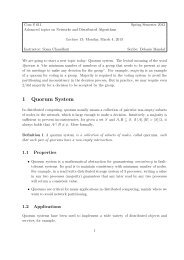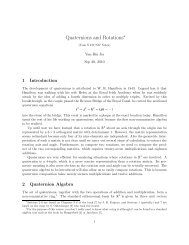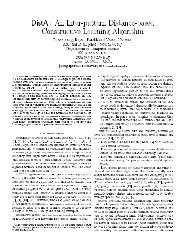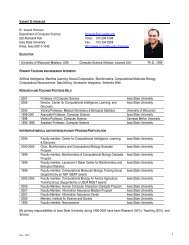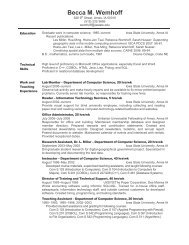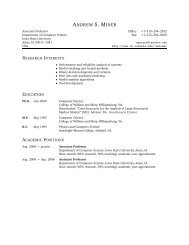Geocasting in Mobile Ad Hoc Networks: Location-Based ... - CiteSeerX
Geocasting in Mobile Ad Hoc Networks: Location-Based ... - CiteSeerX
Geocasting in Mobile Ad Hoc Networks: Location-Based ... - CiteSeerX
Create successful ePaper yourself
Turn your PDF publications into a flip-book with our unique Google optimized e-Paper software.
ilar criteria. Cont<strong>in</strong>u<strong>in</strong>g <strong>in</strong> this fashion, the location-based<br />
multicast protocols with directed antennas may decrease the<br />
cost of ad hoc multicast.<br />
C<br />
E<br />
S<br />
A<br />
F<br />
B<br />
D<br />
Multicast Region<br />
<strong>Mobile</strong> hosts with<br />
a directed antenna<br />
Transmission range<br />
of a mobile host<br />
Figure 10. Directed Antenna Utilization for<br />
<strong>Location</strong>-<strong>Based</strong> Multicast<br />
6 Conclusion<br />
This paper focuses on the problem of geocast<strong>in</strong>g –<br />
broadcast<strong>in</strong>g to every node <strong>in</strong> a specified geographical area<br />
– <strong>in</strong> mobile ad hoc environments. In this paper, the specified<br />
geographical area is called the multicast region, and<br />
the set of nodes that reside with<strong>in</strong> the specified multicast region<br />
is called a location-based multicast group. We propose<br />
two location-based multicast algorithms. The proposed algorithms<br />
limit the forward<strong>in</strong>g space for a multicast packet<br />
to the so-called forward<strong>in</strong>g zone. Simulation results <strong>in</strong>dicate<br />
that proposed algorithms result <strong>in</strong> lower message delivery<br />
overhead, as compared to multicast flood<strong>in</strong>g. As simulation<br />
results show, while reduc<strong>in</strong>g the message overhead<br />
significantly, it is possible to achieve accuracy of multicast<br />
delivery comparable with multicast flood<strong>in</strong>g. We also discuss<br />
how the basic location-based multicast schemes may<br />
be optimized to improve performance. Evaluation of these<br />
optimizations is a subject of future work. Also, similar to<br />
traditional multicast algorithms, it is possible to implement<br />
a location-based multicast by ma<strong>in</strong>ta<strong>in</strong><strong>in</strong>g a multicast tree.<br />
A comparison between the algorithms presented <strong>in</strong> this paper<br />
and the alternative approach of ma<strong>in</strong>ta<strong>in</strong><strong>in</strong>g a multicast<br />
tree is also a topic for further work.<br />
Acknowledgements<br />
We thank the referees for their helpful comments.<br />
10<br />
References<br />
[1] Iowa State University GPS page. Web site at<br />
http://www.cnde.iastate.edu/gps.html.<br />
[2] <strong>Mobile</strong> ad-hoc networks (Manet) charter. Web site at<br />
http://http://www.ietf.org/html.charters/manet-charter.html.<br />
[3] I. F. Akyildiz, S. M. Joseph, and Y.-B. L<strong>in</strong>. Movementbased<br />
location update and selective pag<strong>in</strong>g for PCS networks.<br />
IEEE/ACM Trans. on Network<strong>in</strong>g, 4(4):94–104,<br />
1996.<br />
[4] C. Alaett<strong>in</strong>oglu and et al. MaRS programmer’s manual -<br />
version 1.0. Technical Report TR 91-107, The University of<br />
Maryland, July 1991.<br />
[5] T. Ballardie. Core based trees (CBT) multicast rout<strong>in</strong>g architecture.<br />
In RFC 2201, September 1997.<br />
[6] S. Basagni and et al. A distance rout<strong>in</strong>g effect algorithm<br />
for mobility (DREAM). In ACM/IEEE Int. Conf. on <strong>Mobile</strong><br />
Comput<strong>in</strong>g and Network<strong>in</strong>g (MobiCom ’98), October 1998.<br />
[7] Bommaiah, McAuley, Talpade, and Liu. AMRoute: <strong>Ad</strong>hoc<br />
multicast rout<strong>in</strong>g protocol (Internet-Draft), August 1998.<br />
[8] C. Chiang, M. Gerla, and L. Zhang. Shared tree wireless network<br />
multicast. In Proc. of 6th Int. Conf. on Computer Communications<br />
and <strong>Networks</strong>, pages 28–33, September 1997.<br />
[9] S. Corson and J. Macker. <strong>Mobile</strong> ad hoc network<strong>in</strong>g<br />
(MANET): Rout<strong>in</strong>g protocol performance issues and evaluation<br />
considerations (Internet-Draft), October 1998.<br />
[10] S. Deer<strong>in</strong>g and et al. Protocol <strong>in</strong>dependent multicast-sparse<br />
mode (PIM-SM): Motivation and architecture (Internet-<br />
Draft), October 1996.<br />
[11] S. Deer<strong>in</strong>g and et al. Protocol <strong>in</strong>dependent multicast version<br />
2-dense mode specification (Internet-Draft), May 1997.<br />
[12] C. Huitema. Rout<strong>in</strong>g <strong>in</strong> the Internet. Prentice Hall, 1995.<br />
[13] T. Imiel<strong>in</strong>ski and J. C. Navas. Geographic address<strong>in</strong>g, rout<strong>in</strong>g,<br />
and resource discovery with the global position<strong>in</strong>g system.<br />
Communications of the ACM Journal, 1997.<br />
[14] L. Ji and M. S. Corson. LAM: Lightweight adaptive multicast<br />
protocol (Internet-Draft), August 1998.<br />
[15] Y.-B. Ko and N. H. Vaidya. <strong>Location</strong>-aided rout<strong>in</strong>g (LAR) <strong>in</strong><br />
mobile ad hoc networks. In ACM/IEEE Int. Conf. on <strong>Mobile</strong><br />
Comput<strong>in</strong>g and Network<strong>in</strong>g (MobiCom’98), October 1998.<br />
[16] Y.-B. Ko and N. H. Vaidya. <strong>Location</strong>-based multicast <strong>in</strong> mobile<br />
ad hoc networks. Technical Report 98-018, CS Dept.,<br />
Texas A&M University, September 1998.<br />
[17] Y.-B. Ko and N. H. Vaidya. Optimizations for location-aided<br />
rout<strong>in</strong>g (LAR) <strong>in</strong> mobile ad hoc networks. Technical Report<br />
98-023, CS Dept., Texas A&M University, November 1998.<br />
[18] Metricom Web Page. http://www.metricom.com.<br />
[19] J. C. Navas and T. Imiel<strong>in</strong>ski. Geocast - geographic address<strong>in</strong>g<br />
and rout<strong>in</strong>g. In ACM/IEEE Int. Conf. on <strong>Mobile</strong> Comput<strong>in</strong>g<br />
and Network<strong>in</strong>g (MobiCom’97), September 1997.<br />
[20] K. Obraczka and G. Tsudik. Multicast rout<strong>in</strong>g issues <strong>in</strong> ad<br />
hoc networks. In IEEE ICUPC, October 1998.<br />
[21] T. Pusateri. Distance vector multicast rout<strong>in</strong>g protocol<br />
(Internet-Draft), March 1998.<br />
[22] S. Ramanathan and M. Steenstrup. A survey of rout<strong>in</strong>g techniques<br />
for mobile communication networks. ACM/Baltzer<br />
<strong>Mobile</strong> <strong>Networks</strong> and Applications, pages 89–104, 1996.<br />
[23] C. Wu, Y. Tay, and C.-K. Toh. <strong>Ad</strong> hoc multicast rout<strong>in</strong>g protocol<br />
utiliz<strong>in</strong>g <strong>in</strong>creas<strong>in</strong>g id-numbers (AMRIS) functional<br />
specification (Internet-Draft), November 1998.



